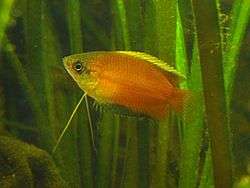Honey gourami
| Honey gourami | |
|---|---|
 | |
| Scientific classification | |
| Kingdom: | Animalia |
| Phylum: | Chordata |
| Class: | Actinopterygii |
| Order: | Perciformes |
| Family: | Osphronemidae |
| Genus: | Trichogaster |
| Species: | T. chuna |
| Binomial name | |
| Trichogaster chuna (F. Hamilton, 1822) | |
| Synonyms | |
| |
The honey gourami (Trichogaster chuna) is a species of gourami native to India and Bangladesh.[2]
Distribution and habitat
The honey gourami is typically found in rivers and lakes in its native range. It inhabits areas of thick vegetation in soft and poorly mineralised waters. This fish prefers the top and middle levels of the water.[3]
Appearance and anatomy
They have orange-colored bodies. This species can reach a length of 7 centimetres (2.8 in) TL.[2] Male specimens of this fish, typical of many gouramis, are generally more colourful than their female counterparts. They exhibit bright orange colouring around the throat region, which at breeding time becomes much brighter and is used to court the female. The undersides of the males become black when breeding. Males also exhibit somewhat of an orange tinge in their fins, with the exception of the caudal fin. The male also has longer fins, with a pointed dorsal fin and extended anal fin rays.[4] Two other color varieties have been selectively bred—a red-orange variety known as sunset or robin red, and a lighter variety called gold. This can sometimes lead to confusion, in part because the red-orange type can look like the red variety of dwarf gourami (Colisa lalia).
In the aquarium
The honey gourami is generally considered to be a non-aggressive community fish, ideal for small aquaria (10 gallons and up). However like other gouramis, male honey gouramis can be aggressive towards each other. For this reason they are best kept apart, unless the tank is large enough for the males to establish territories. A tank that includes this fish should be planted and decorated to provide adequate cover. Providing cover is necessary as this species, like the similarly sized dwarf gourami, can be rather timid, and aggressive tankmates are best avoided. Good tankmates include non-fin nipping tetras, non-fin nipping barbs, corydoras, platys and other gouramis. Water temperature should be maintained at around 22 to 28 °C. Water chemistry is not critical, but extremes should be avoided.[5]
A colour variant of the honey gourami is the red honey gourami, which is slightly redder in colour. When in breeding condition, the male becomes even darker red/orange in colour.
Breeding
The honey gourami is a bubble nest builder that uses plants to help bind together the bubbles. The water level should be reduced to 8 in during spawning, and the temperature should be approximately 28 °C (82 °F) and with a pH of around 7. After spawning both adults should be removed. The eggs hatch after two days and the fry become free swimming three days later (Ter Morshuizen 2007). When they commence free swimming the fry should be fed infusoria and brine shrimp, and a week later finely ground flakes. Freeze-dried tablets may also be fed to older fry.
References
- ↑ Vishwanath, W. 2010. Trichogaster chuna. In: IUCN 2013. IUCN Red List of Threatened Species. Version 2013.2. <www.iucnredlist.org>. Downloaded on 29 March 2014.
- 1 2 Froese, Rainer and Pauly, Daniel, eds. (2014). "Trichogaster chuna" in FishBase. February 2014 version.
- ↑ Honey Gourami, Trichogaster chuna, Syn: Colisa Chuna, Family: Osphronemidae, Subfamily: Luciocephalinae
- ↑ Sanford, Gina (1999). Aquarium Owner's Guide. New York: DK Publishing. ISBN 0-7894-4614-6.
- ↑ Dawes, John (2005). Complete Encyclopedia of the Freshwater Aquarium. London: FIREFLY Books. ISBN 1-55297-544-4.
